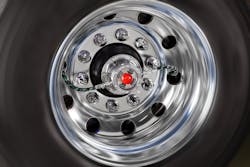Data drives action when it comes to fleet tire monitoring
This scenario isn’t uncommon: Imagine a truck driver leaves a yard with a trailer he or she just picked up. They don’t realize it at the time, but they missed a leak in one of the inner tires during pre-trip inspection. It leaks slowly, so it’s not noticed right away, but the truck fights it until the tire goes flat. Now the driver is stuck trying to find the solution to a big problem that used to be a small problem, all while wasting time, money and preventing them from keeping a company's delivery promise.
In the commercial trucking world, success revolves around the tires more than some are willing to admit. Drivers focus on payloads and routes, but the only true points of contact on the open road are the tires.
When there’s an issue, those tires don’t often show clear signs of distress quickly. So how do fleets catch little issues before they become larger ones? The answer, as it often does, lies in the data.
Defining the options
Many in the industry are familiar with tire pressure monitoring systems (TPMS) or automatic tire inflation systems (ATIS). These systems can serve as safeguards against breakdowns. But, how do they work and how does the data turn into decision-making information?
Both of these systems can be integrated into a larger telematics system. Telematics is a broad term that encompasses collecting information from trucks and trailers remotely while they’re in operation, and aggregating, analyzing and displaying the information through a web portal.
TPMS measures the air pressure within a tire. If the tire pressure drops below a certain threshold, the driver and the dispatcher are notified.
There are different system options for the driver interface, ranging from a general alert to a visual display of the exact tire pressure. This same collected data is also sent to the fleet, and can be integrated with the telematics solution interface.
The primary value of TPMS is alerting the driver and fleet of the tire’s status. TPMS is not able to resolve the issue by adding more air to the tire automatically, but the information from the system helps the dispatcher schedule maintenance or find a nearby facility to fix the problem. The leak is still a disruption, but it is minimized.
ATIS, in addition to monitoring the tire’s status, provides additional protection by inflating the tire with air in real time. Tire pressure adjustments can happen often due to road conditions or temperature changes, and an ATIS can regulate the tire pressure for optimal performance. This additional functionality can get a driver and his or her assets to a safe location.
An important item to note is that ATIS typically needs trailer power in order to operate and inflate the tire.
Managing tire air loss
Less-than-optimal tire inflation manifests in many symptoms, and they all start small. They don’t often stay that way, though, as the issue escalates.
First, improper inflation can cause excess drag and stress on the vehicle. The engine has to work harder to pull the trailer, which impacts speed and fuel economy.
Also, the tire will wear out much more quickly with underinflated tires. This leads to more maintenance and higher operating costs, in addition to the danger of a tire blowing out on the roadway.
Finally, that same tread problem decreases traction and handling on the road. Underinflated tires won’t be as responsive on the roadway, leading to potential harm to the equipment or other motorists.
How tire monitoring mitigates issues
With these two telematics systems differentiated, and the symptoms identified, what are some other real-world ways that these systems mitigate issues? There are a number of examples from the field seen over the years:
- If a trailer has been sitting in a yard for an extended period of time with a flat tire, TPMS can alert the driver that the trailer needs maintenance, prior to leaving the yard. This provides clear value with the TPMS solution, so that a truck does not pick up a trailer with an issue and risk breakdown.
- If a tire has a slow leak—say, from picking up a nail on the road—the tire pressure may decrease over time, but it may not be visible to the eye until it’s too late. TPMS can alert the driver or dispatcher of the issue to avoid catastrophe.
- In the same event of a nail in a tire, ATIS can also provide crucial value. It would detect a loss of pressure and automatically start to add air to compensate. Normally, a driver or fleet would not know this event has occurred until they have stopped and inspected the sensor unit on the front of the trailer. ATIS would alert the driver or fleet that there is an issue.
The person that arguably benefits the most from TPMS or ATIS isn’t the driver, it’s the fleet. With the addition of a telematics system, fleets can be advised of the event and take action so the truck can get to a safe spot to rectify the issue.
Now, the final question is, how valuable is this data? When saving time, extending the life of equipment and being more efficient are factored together, this data can help streamline an entire fleet and make a significant impact on the bottom line.
Again, the benefit of these systems—and the data delivered by them—is that although they will not totally eliminate problems, the problems can be minimized. The data will ultimately lead to better business decisions.
Lee Alexander joined Stemco in 2018 as Director of Product Management, IoT Platforms. He has worked for EnPro, Stemco’s parent company, for the last 10 years in product management, engineering and innovation leadership positions. His current role involves developing product strategy and value proposition while working with cross functional teams to ensure project execution to deliver high-performance products that exceed customer’s expectations.
